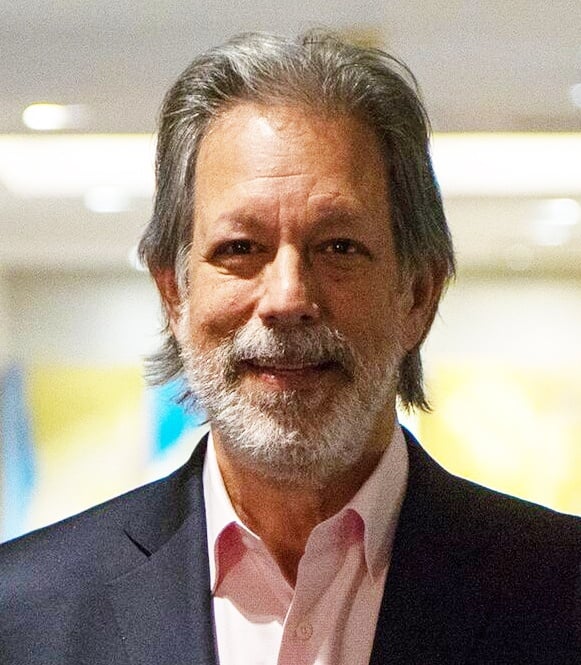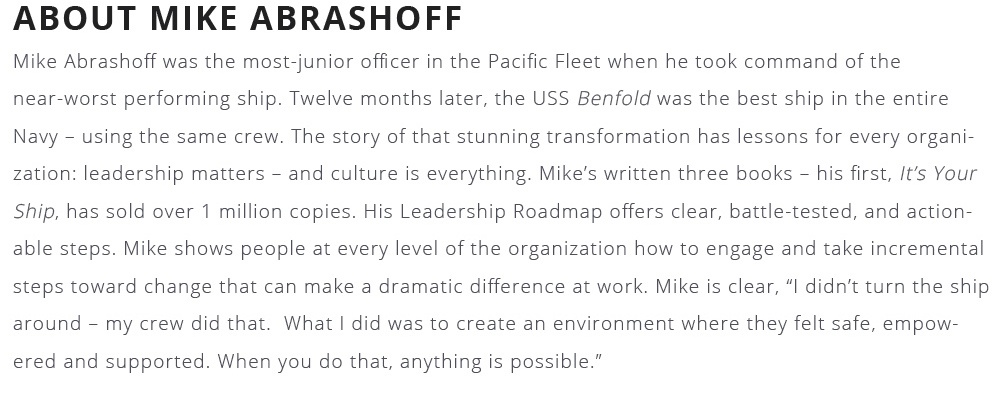HOW MIKE ABRASHOFF MADE THE USS BENFOLD THE BEST DAMN SHIP IN THE NAVY
Managing/Leading Change | Leadership | Organizational Culture | Mike Abrashoff
Mike Abrashoff - "It Was All About the Culture"
Imagine you’re put in charge of a new project. You’re given goals and objectives and a team of people to work with. This team, though, has a horrible performance history. In fact, they are among the worst teams in the organization, yet your job is to meet the objectives – no excuses. And – you can’t fire bad performers, or financially reward good performers, or hire new help.
What would you do?
That’s the situation MIKE ABRASHOFF, author of It's Your Ship, faced when he became the youngest commander in the U.S. Navy’s Pacific Fleet at age 36. The ship was the USS Benfold, and it ranked near the bottom of the performance rating in the fleet. Its safety record was abysmal, morale was worse, and its re-enlistment rate ranked at an embarrassing 8%.
Welcome Aboard, Captain Abrashoff –
Change-of-Command Ceremony
“I’d never see such a blatant display of disrespect by a crew for its outgoing captain,” Mike Abrashoff said of the deck ceremony for his predecessor. “As he stepped into the tender to disembark the ship the crew cheered him off. They were thrilled to see him go.” Sizing up the situation, Abrashoff was certain this was going to be his last stop of his career. He didn’t see how he could be successful in this environment but he knew he had to do something dramatic. He didn’t want a similar send-off at the end of his time on the ship.
Time for a Different Leadership Approach
As he settled into his command, there was one thing Mike Abrashoff quickly realized: he needed to reinvent his leadership style to have any hope of surviving, let alone succeeding. “The one thing in my control was my leadership approach and the culture it created. But nothing I’d done to that point had prepared me for this challenge. If things were going to change on the ship, the change needed to start with me,” he said.
Start with the Crew
Mike Abrashoff decided to begin by getting to know every one of his crew members – all 310 of them - as quickly as possible. He wanted to know why they joined the Navy and what they hoped to accomplish there. “What I found out in those interviews was how smart my crew was. I remember one sailor who got 1490 out of 1600 on her SAT. As soon as I realized they had the talent, but lacked engagement, I understood what I needed to do."
Swapping Command and Control with Commitment and Cohesion
"I began asking each sailor three questions in my interviews 1) what do you like most about the USS Benfold; 2) what do you like least; and 3) what one thing would you change (except for the captain!) if you could? The idea was to take all of their intelligence and bring it to bear on our goals. As they came to know and trust me, they realized I’d listen to them and respect their opinion. On a ship, as with any organization, the captain only succeeds if everyone is committed to the same goals. As a captain, I can give orders, but I can’t order excellence."
What Abrashoff wanted was to unleash the power of his crew to turn around a ship that had the potential to perform way beyond its current level.
Sending a Signal to the Crew - Servant Leadership
Every Sunday when the ship was at sea, lunch was served on the deck. Typically, Navy officers could cut in at the head of the line and then take their meals up to the next deck while the crew sat and ate together. “My view was as captain, I worked for the crew. I was there to serve them. So when lunch time came around, I went to the end of the line – and then sat with the crew on the lower deck. Every officer then followed suit. The officers weren’t bad people – they were just following Navy tradition. I wanted to make the point that no one on the crew is more important than anyone else – and for us to stay safe and accomplish our goals, we were in this together.” It was Abrashoff’s job to send a message that things had changed and the crew took notice that something different was going on.
Unleash exceptional performance in your organization. Video tips from top leadership speaker MIKE ABRASHOFF, author of It's Your Ship.
We’ve Always Done It This Way
The status quo is the enemy of improvement. And in an organization like the Navy, steeped in tradition and regulations, sailors can simply disengage and just do what’s expected. “When I’d ask why things were done a certain way, I’d get some version of ‘That’s how we’ve always done it’. I actually banned those words as a way of getting sailors to engage and really participate in the performance solution. I knew the only hope of raising performance was to engage them at their most creative level.”
It’s Your Ship
“At one of my first meetings with the crew I told them, I don’t care what your rank or how long you’ve been on the ship – if you have an idea how we can do something better, speak up. You can come to work every day and challenge every process, every procedure, every tradition, and every custom. The only rule was: it can’t cost more money. The budget was set. But if it’s a good idea, we’ll initiate it on the spot. As problems arose, crew members would come to me and I’d ask them – ‘What would you do? It’s your ship. You tell me.’ Soon they understood they had been empowered to come to work to think and make a difference. The feedback from the crew was extraordinarily positive. Many told me it was the first time in their careers that they looked forward to coming to work every day.”
Stop Painting the Ship
Mike Abrashoff offers up many examples of how his sailors were challenging the status quo. One particularly powerful one has to do with painting the ship. It takes a month to paint the ship and it needs to be done every other month because the rust stains mar the finish and run down the sides of everything. One sailor came to Abrashoff and pointed out that swapping the ferrous metal fasteners (nuts, bolts, etc.) topside with stainless steel (which doesn’t rust in salt water) would eliminate a lot of repetitive work. It was a no-brainer, but no one had ever challenged the process. Abrashoff adopted the idea and the ship not only went ten months between paintings, but the Navy adopted the program. Every ship now uses stainless steel topside – saving millions of dollars – all because one sailor felt he could challenge convention and not be ridiculed for doing so.
Catching People Doing Something Great
Captains in the Navy spent time prowling the ship looking for people who weren’t performing. Mike Abrashoff had a different approach. He looked for sailors who were doing great work and thanked them for their effort. One way of doing that was by awarding them a Navy Achievement Medal. “I walked around with medals in my pocket and when I came across a sailor doing something great I’d award them a medal on the spot and thank them for their hard work and dedication. These medals were important because sailors got one bonus point on their advancement exam. I was allowed to give out 15 medals each year but I figured the people at the Bureau of Navy Personnel in Washington weren’t paying close attention. My first year I handed out 115! You could see the morale on the ship start to shift as people understood this was not the same ship’s culture. For the first time someone wasn’t walking around looking to chew them out – but to praise and thank them for doing a good job. The change got people’s attention.”
SUPPLEMENTAL READING -
Employee Engagement Ideas from Top Leadership Speaker Mike Abrashoff and
Leadership Speaker Mike Abrashoff: Command & Control is Dead
Aiming to be Average
“There’s a danger in having other people set goals for you,” Mike Abrashoff explained. “My goal was to wake up every morning and get to average. I had all kinds of metrics that showed what the average performance was. As my crew became more engaged, it was clear to me that “average” was shooting low compared to our capabilities. We weren’t competing with other ships – we were in competition with ourselves. Once the crew saw that too, performance began to explode. They became evangelists for rethinking every process, every role, every aspect of how we went about our daily work.”
Culture is Everything
In just twelve months the USS Benfold went from being the near-worst ship in the Navy to the best ship in the fleet – using the same crew. This is worth repeating: this complete turnaround occurred using the very same people who were previously falling far short of expectations. That achievement has served to inspire leaders and organizations everywhere because the message was crystal clear: organizational culture is at the heart of unleashing the power and commitment that is in every organization’s people.
Abrashoff’s Transfer Ceremony – Coming Full Circle
Remember that change-of-command ceremony for Abrashoff’s predecessor? That affair customarily takes 90 minutes with lots of pomp and circumstance, Navy brass in attendance, even a band. By then his crew knew how much he cared about them as people. Abrashoff stood up for them, gave them latitude to bring their best gifts to the job, and in return, they led the turnaround of the ship that became the dramatic example of organizational excellence. The ship had nearly 100% re-enlistment rate and was the ship sailors most wanted to work on. The safety record was the envy of every ship in the Navy and by every measure the ship was the best in the fleet. Instead of 90 minutes, Abrashoff's ceremony lasted 45 seconds. His parting speech consisted of five words: “You know how I feel.” Then, he turned and saluted them and departed the USS Benfold for the last time. As one sailor emailed him later that day, there wasn’t a dry eye on deck.
“It never ceased to amaze me what my sailors could accomplish. My sailors turned around their own ship. It wasn’t me,” says Mike.
TELL US YOUR STORY - Have you ever found yourself in a situation that required you to change your leadership style? Who was the best leader you've ever worked with/for? Tell us about it below or click here to learn more about Mike Abrashoff and his approach to leadership.
About Tony D'Amelio
Tony has spent his career putting talented people and audiences together, first in the music business and later representing the world's leading speakers. After concluding 27 years as Executive Vice President of the Washington Speakers Bureau, Tony launched D'Amelio Network, a boutique firm that manages the speaking activities of a select group of experts on business, management, politics and current events. Clients include: Mike Abrashoff, Mariana Atencio, Chris Barton, Lisa Bodell, Geoff Colvin, Daryl Davis, Suneel Gupta, Ron Insana, Katty Kay, Polly LaBarre, Nicole Malachowski, Ken Schmidt, and Bob Woodward.

.png)

.jpg)



